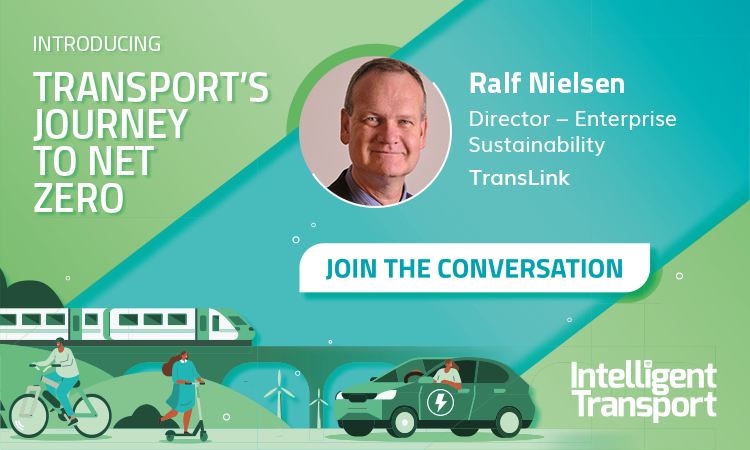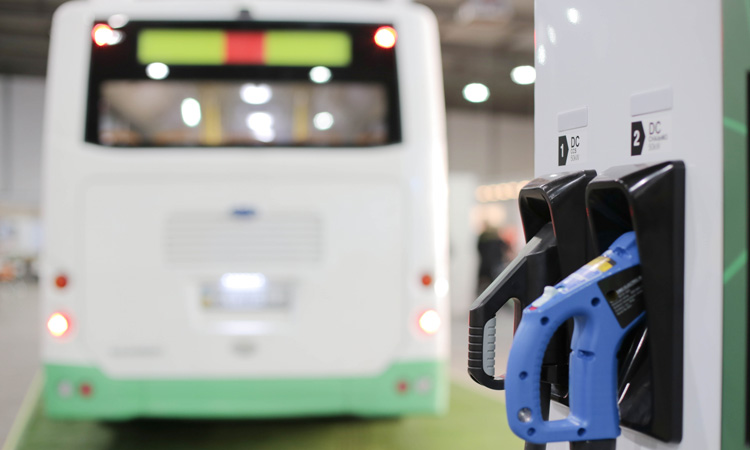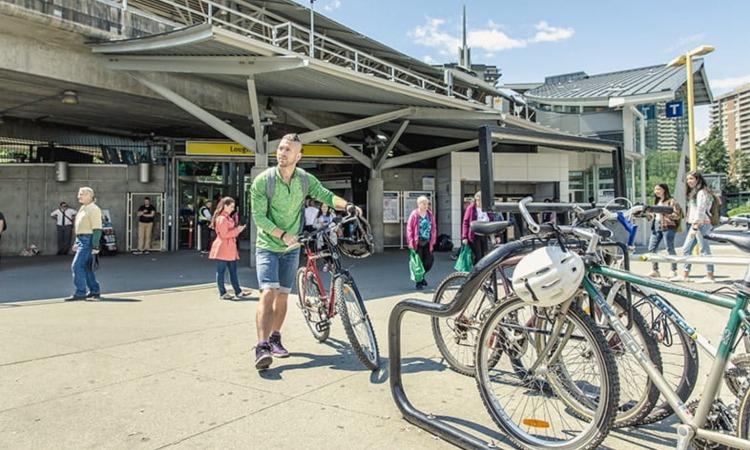Transport’s journey to net zero: Electrification will drive our transition to a carbon-free future, says TransLink
- Like
- Digg
- Del
- Tumblr
- VKontakte
- Buffer
- Love This
- Odnoklassniki
- Meneame
- Blogger
- Amazon
- Yahoo Mail
- Gmail
- AOL
- Newsvine
- HackerNews
- Evernote
- MySpace
- Mail.ru
- Viadeo
- Line
- Comments
- Yummly
- SMS
- Viber
- Telegram
- Subscribe
- Skype
- Facebook Messenger
- Kakao
- LiveJournal
- Yammer
- Edgar
- Fintel
- Mix
- Instapaper
- Copy Link
Posted: 28 September 2022 | Ralf Nielsen - TransLink | 1 comment
In the latest instalment of Intelligent Transport’s exclusive sustainable transport Q&A series, Ralf Nielsen, Director – Enterprise Sustainability at TransLink. TransLink is Metro Vancouver’s integrated, multimodal transportation authority, unique as both a transit operator and responsible for planning the regional transportation system. Ralf discusses the key challenges that the authority faces in decarbonising its mass transit fleets, as well as the significant contribution government investments in public transportation have in supporting transport operators and authorities meet their collective climate and greenhouse gas reduction targets.


The ever-pressing challenges of poor air quality and traffic congestion have been a key focus for the transport industry, as operators and authorities strive to achieve their net zero targets. How big a part does the decarbonisation of public transport play in reducing Metro Vancouver’s carbon emissions?
Transportation accounts for 35 per cent of Metro Vancouver’s greenhouse gas (GHG) emissions. Although public transit accounts for only 2.7 per cent of regional transportation emissions, it is still critical that TransLink meets our regional, provincial and global climate targets, in order to continue improving air quality in the region. Public transit plays a vital role in reducing carbon emissions, by providing convenient, fast, reliable service that makes it easier for people to reduce their use of motor vehicles.
Public transit plays a vital role in reducing carbon emissions, by providing convenient, fast, reliable service that makes it easier for people to reduce their use of motor vehicles”
As a transportation authority, we also have a significant role to play in reducing GHGs from cars and trucks in the region, which are the sources of the majority of transportation emissions in Metro Vancouver. We have to look at all of the various modes, technologies, means and methods to decarbonise transportation. This means a combination of strategies, such as investing in the expansion of public transit; transportation demand management; land use planning to enable people to live affordably and closer to transit; tackling congestion; and investing in cycling and walking infrastructure, electric vehicles (EVs) and micro-mobility. A diverse suite of strategies and tools will be needed to enable the region to have carbon-free transportation by 2050.
What are the immediate challenges that TransLink is facing in decarbonising its public transport fleet?
We face several key challenges to decarbonising our fleet.
First of all, we’d like to move faster, but are constrained. Our current roadmap to net zero and target to reduce GHG emissions by 45 per cent by 2030 is based on electrification and renewable natural gas. The timelines for design and construction of the charging infrastructure are in the order of four to six years, whereas the procurement of battery-electric buses is in the one to one-and-a-half-year timeline. Electrification of our fleet and facilities is a time and capital intensive process. The inherent complexities of any large capital project (lengthy approval, permitting and stakeholder review processes) pose risks to meeting our reduction targets, particularly for 2030.
We’re learning as we go, alongside others in the industry… as standards are being developed by the various original equipment manufacturers”
Second, full transition to zero-emission fleet and infrastructure takes a considerable amount of time based on fleet lifecycle replacement schedules. That’s why were looking at changing our target asset life cycle from 17 years to 12 or 14.
We’re learning as we go, alongside others in the industry. We will benefit from industry standards being developed by original equipment manufacturers (OEMs) to ensure seamless interoperability between charging infrastructure and battery-electric buses.
Finally, while we electrify our fleet, the production and availability of renewable fuels continues to increase. This presents an opportunity. Significant investments in production from our fuel producers and providers are starting to pay off. By 2024, all of our compressed natural gas buses will be running on renewable natural gas, providing us with a significant GHG reduction for our bus fleet. Renewable fuels are a key strategy that will enable us to meet our 2030 target while we continue to electrify other parts of our fleet.


What projects does TransLink currently have in the pipeline that will help to achieve a more sustainable transport system in Metro Vancouver?
In January 2022, we released the Regional Transportation Strategy for 2050 (Transport 2050). This Strategy, together with Transport 2050 – First Ten Year Priorities, and a range of ongoing projects include:
Rapid transit
- New Broadway Subway Line currently under construction
- Newly approved Surrey Langley SkyTrain (all-electric, near zero-emission) line, with eight new stations that will serve communities that are expected to grow by 1.2 million by 2050
- The Millennium Line SkyTrain extension from Arbutus to the University of British Columbia
- Exploring other potential SkyTrain extensions, including Newton in Surrey and Port Coquitlam.
Bus
- More than doubling bus service levels across the region
- Developing approximately 170km of new rapid transit on up to 11 corridors, including:
- Up to nine bus rapid transit (BRT) routes using new zero-emission buses on dedicated, traffic-separated lanes
- A rapid transit connection to the North Shore.
Multimodal mobility
- The Burnaby Mountain Gondola to Simon Fraser University
- Investing in 450km of new traffic-separated cycling paths
- Innovating in automated, electric and shared mobility
- Building the foundation for the digitalisation of mobility.
Regional sustainability and resilience:
- Continued support in planning and policy making to stimulate Transit Oriented Community developments in the region
- Working on our newly established Real Estate Development Program to create affordable, climate-resilient housing and commercial developments
- Improving our relationships with Indigenous Nations and urban Indigenous Peoples, and making progress on reconciliation
- Making our infrastructure more resilient to seismic risks and climate change
- Understanding the social equity impacts of our investments on disadvantaged communities and ensuring that we have the data and consultation to maximise our investments for our customers
- Sustainable Procurement Strategy and Internal Shadow Price of Carbon Policy.


Credit: TransLink
Although public transport has seen a global increase in ridership post-pandemic, car use continues to be more resilient. What is being done to encourage modal shift from the private car, and how significant is improving active travel and public transport infrastructure in achieving this?
Our collective target is to reduce emissions by 65 per cent by 2030″
We are working closely with Metro Vancouver and the Province of British Columbia on strategies, policy instruments and tools to help drive down emissions in light duty vehicles throughout the region. Our collective target is to reduce emissions by 65 per cent by 2030. This is an ‘all hands on deck’ project and is critically important to creating a more sustainable transportation system in the region. We have whole teams working in New Mobility who drive research projects, pilot projects, stimulate supplier innovation, etc. We are also driving the development, with peers, on identifying and supporting the build out of EV charging infrastructure in the region.
What are the biggest barriers to encouraging active travel in Metro Vancouver?
The key to driving the wider adoption of active transportation is similar to other forms of mobility: it needs to be convenient and accessible. This includes ensuring safety and security, dedicated infrastructure (separation from motor vehicles) and, finally, convenient connections to other modes of mobility.
How big a contribution must TransLink make in order for Greater Vancouver to meet its climate goals?
Our greatest contribution to reaching our collective climate goals is to make transportation in the region convenient, affordable, fast and accessible to everyone”
We’ve estimated that, over the next 10 years, we’ll be making over $1.2 billion in capital investments in our transition to zero-emission. By 2040, we will have eliminated fossil fuels from our bus fleet. But our greatest contribution to reaching our collective climate goals is to make transportation in the region convenient, affordable, fast and accessible to everyone. We need to make transit, and other multimodal solutions, more attractive, convenient and seamless – particularly for long trips. We also need to make walking, cycling and micro-mobility the preferred solution for short trips in the region. Without these investments, continued increase in congestion will have significant impacts on our economy, productivity, human health, affordability and safety in the region.
In an ideal world, what would a net zero transport system look like to you?
I’d like to see us provide affordable transit services to our entire population across the region, including our Indigenous Nations and vulnerable populations”
I’d love to be able to have people and businesses travel in the region with zero emissions, and zero-criteria air contaminants, in a way that is affordable and accessible to all. Pre-pandemic, more than 50 per cent of our ridership took zero-emission transit modes (SkyTrain, Electric-Trolley) every day. I’d like to see this at 100 per cent by 2040. I’d also like to see us provide affordable transit services to our entire population across the region, including our Indigenous Nations and vulnerable populations.
Finally, I’d like to see our transport system (and other infrastructure systems it relies upon) to be adapted to the impacts of our changing climate, including having the resilience to bounce back from severe weather events, such as flooding and heat waves, to keep our staff and customers safe and comfortable.


In Ralf’s 26-year career in Canada and the U.S., he’s held progressively senior roles where climate and sustainability intersect with business strategy and risk management. In 2016, he was recognised for his sustainability leadership by becoming an honouree of Canada’s Clean 50. Ralf owes his big picture and optimistic views to growing up on the Canadian prairies, past clients and education in Physics and Industrial Design.
If you would like to take part in our ‘Transport’s journey to net zero’ series, or would like to nominate a colleague to take part, please email: Halimah Haque, Editorial Assistant, Intelligent Transport.
Related topics
Accessibility, Air Quality, Alternative Power, Fleet Management & Maintenance, Infrastructure & Urban Planning, Mobility Services, Multimodality, Public Transport, Sustainable Urban Transport, Transport’s Journey to Net Zero Series
Related modes
Bikes & Scooters, Bus & Coach
Related cities
Vancouver
Related countries
Canada
Related organisations
Translink
Related people
Ralf Nielsen









I appreciate the informative article and expertise. keep up the great work!